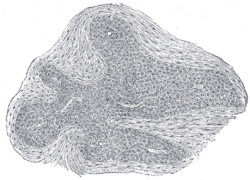- Coccygeal glomus
-
Coccygeal glomus 
Section of an irregular nodule of the glomus coccygeum. X 85. The section shows the fibrous covering of the nodule, the bloodvessels within it, and the epithelial cells of which it is constituted. Latin glomus coccygeum Gray's subject #277 1281 Artery median sacral artery The coccygeal glomus (coccygeal gland or body; Luschka’s gland) is placed in front of, or immediately below, the tip of the coccyx.
Anatomy
It is about 2.5 mm. in diameter and is irregularly oval in shape; several smaller nodules are found around or near the main mass.
It consists of irregular masses of round or polyhedral cells, the cells of each mass being grouped around a dilated sinusoidal capillary vessel.
Each cell contains a large round or oval nucleus, the protoplasm surrounding which is clear, and is not stained by chromic salts.
Clinical significance
It may appear similar to a glomus tumor.[1]
References
- ^ Santos L, Chow C, Kennerson A (2002). "Glomus coccygeum may mimic glomus tumour.". Pathology 34 (4): 339–43. doi:10.1080/003130202760120508. PMID 12190292.
This article was originally based on an entry from a public domain edition of Gray's Anatomy. As such, some of the information contained within it may be outdated.
Posteriorvisceralterminal/
common iliacAnteriorvaginal branch ♀V/IVaccompanying of ischiadic nerve · crucial anastomosisPosteriorsee arteries of lower limbsCategories:- Anatomy stubs
- Human anatomy
Wikimedia Foundation. 2010.
